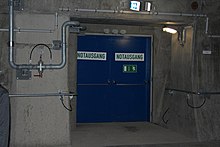Self-rescue
The self-rescue is the faculty themselves from dangerous situations to rescue. As a preventive measure, this also includes knowing how to prevent dangerous situations. The technical term self-rescue means: people can save themselves from the danger area on their own .
Many safety concepts include self-rescue for people who are endangered by the event but still able to act independently, because especially with large crowds, the rescue workers would be overwhelmed if they had to accompany each individual. However, self-rescue of a larger group requires self-discipline from those involved in order to avoid panic. The immediate initiation of self-rescue is also very important when recognizing the danger. For example, it is important that drivers in a tunnel save themselves immediately when smoke develops and use the escape routes .
Self-rescue is also expected of passengers in public transport, as it is not easy to remove all passengers on a train in a timely manner. For the self-rescue concept , however, the infrastructure must be right, which is why the installation of sidewalks, handrails, escape route lighting and markings is pushed ahead with rail tunnels , where they are not yet available. Even in large manufacturing plants, it is often necessary that, in the event of a fire, the workers in the building use escape hoods to get themselves to safety.
In the field of water rescue , this knowledge is z. B. taught by the German Life Rescue Society ( DLRG ), the ASB water rescue or the water rescue service in the German Red Cross . In the fire brigade, self-stretchering usually means abseiling in an emergency using a fire line and a fire brigade harness.
